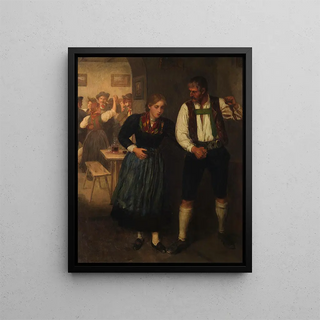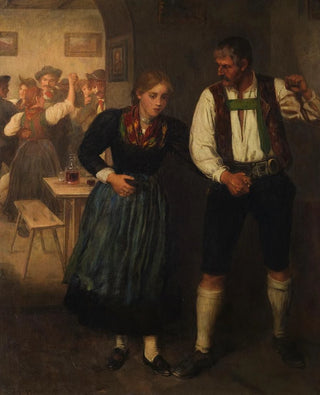Art print | At the Ball - Franz von Defregger


View from behind

Frame (optional)
The art print "Au bal" by Franz von Defregger is an invitation to immerse oneself in a universe where elegance and joie de vivre come together. This ballroom scene, imbued with lightness and refinement, transports the viewer to a suspended moment where dance and conviviality intertwine. With its vibrant colors and festive atmosphere, this canvas evokes the pleasures of social life in the 19th century, while revealing the subtleties of human interactions. Defregger's art, both intimate and universal, invites each person to feel the emotion of a shared moment, where the beauty of costumes and postures blends with the melody of an unforgettable evening.
Style and uniqueness of the work
Franz von Defregger's style is distinguished by his ability to capture moments of life with remarkable precision and sensitivity. In "Au bal," he manages to reproduce not only the aesthetics of an era but also the very essence of human emotions. The faces of the characters, finely detailed, express a range of emotions from joy to melancholy. The fluid movements of the dancers, rendered with great mastery, give an impression of dynamism and lightness. The light, skillfully manipulated, illuminates the scene in a way that emphasizes the details of the sumptuous costumes while creating a warm atmosphere. This work is a perfect example of Defregger's narrative art, which manages to tell a story through movement and expressions, making each gaze a journey into the heart of the celebration.
The artist and his influence
Franz von Defregger, born in 1851 in Austria, is a painter whose work marked his time with his ability to depict daily life with a touch of elegance and romanticism. Influenced by the realist and naturalist movements, he combined impeccable technique with a unique artistic sensitivity. His interest in social scenes and folk traditions made him a keen observer of the customs of his era. Defregger was also a pioneer in the use of color and light, elements that are reflected in his work.

Matte finish

View from behind

Frame (optional)
The art print "Au bal" by Franz von Defregger is an invitation to immerse oneself in a universe where elegance and joie de vivre come together. This ballroom scene, imbued with lightness and refinement, transports the viewer to a suspended moment where dance and conviviality intertwine. With its vibrant colors and festive atmosphere, this canvas evokes the pleasures of social life in the 19th century, while revealing the subtleties of human interactions. Defregger's art, both intimate and universal, invites each person to feel the emotion of a shared moment, where the beauty of costumes and postures blends with the melody of an unforgettable evening.
Style and uniqueness of the work
Franz von Defregger's style is distinguished by his ability to capture moments of life with remarkable precision and sensitivity. In "Au bal," he manages to reproduce not only the aesthetics of an era but also the very essence of human emotions. The faces of the characters, finely detailed, express a range of emotions from joy to melancholy. The fluid movements of the dancers, rendered with great mastery, give an impression of dynamism and lightness. The light, skillfully manipulated, illuminates the scene in a way that emphasizes the details of the sumptuous costumes while creating a warm atmosphere. This work is a perfect example of Defregger's narrative art, which manages to tell a story through movement and expressions, making each gaze a journey into the heart of the celebration.
The artist and his influence
Franz von Defregger, born in 1851 in Austria, is a painter whose work marked his time with his ability to depict daily life with a touch of elegance and romanticism. Influenced by the realist and naturalist movements, he combined impeccable technique with a unique artistic sensitivity. His interest in social scenes and folk traditions made him a keen observer of the customs of his era. Defregger was also a pioneer in the use of color and light, elements that are reflected in his work.






